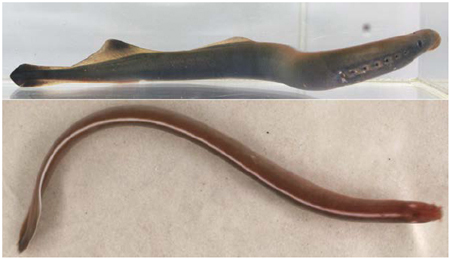| RIKEN Center for Developmental Biology (CDB) 2-2-3 Minatojima minamimachi, Chuo-ku, Kobe 650-0047, Japan |
Jan 31, 2013 –The position occupied by the hagfish, one of the two groups of modern agnathans (jawless vertebrates), within the phylogenetic tree has been a controversial question for decades. Evidence from molecular phylogenetics studies has suggested a closer relationship between the hagfish and the lamprey, than with the gnathostomes (jawed fishes). But some morphological interpretations have pointed to a different scheme. Hagfish, like their fellow agnathan lampreys, have only a single nostril, as opposed to the gnathostome’s two, and also lack many features, such as vertebrae and the lens of the eye, that define vertebrates. These apparent discrepancies have fueled a debate over the evolutionary relationship between hagfish and other vertebrates. There are also disagreements within the research community as to the developmental source of the adenophophysis, which opens into the solitary nostril (called the nasohypophyseal duct) in hagfish – specifically whether it is endodermal in origin, as suggested by some previous studies, or ectodermal, as is the case for both lampreys and the gnathostomes. Finding answers to these questions has long been frustrated by the difficulty in obtaining hagfish embryos for detailed examination. New work by Yasuhiro Oisi and others in the Laboratory for Evolutionary Morphology (Shigeru Kuratani, Group Director) in collaboration with colleagues in CDB and Academia Sinica (Taiwan) provides morphological evidence that reveals that development of the olfactory organs and adenohypophysis is nearly identical in hagfish and lampreys. Published in Nature, this study solidifies our morphological and anatomical understanding of the hagfish as close relatives of the lamprey and sheds new light on the evolution of vertebrate craniofacial structure.
Several years ago, the Kuratani group developed a system for breeding the hagfish Eptatretus burgeri in captivity, a breakthrough that provided the lab with a much-needed supply of embryos after a nearly century-long drought that forced hagfish biologists to rely on studies published in the 19th century. Oisi used this resource to conduct a staged series examination of embryos to examine the development of certain craniofacial features, and to resolve their germ layer origin. Observation of hagfish embryos at the mid-neurula stage revealed that the adenohypophysis arise from the nasohypophyseal plate (or NHP, a median complex of placodes also found in the lamprey, corresponding to a pair of discrete placodes – hypophyseal and nasal – found in gnathostomes). The ectodermal origin of the adenohypophysis was further supported by gene expression profiles consistent with an ectodermal source. This suggests that the developmental differences between hagfish and lampreys are smaller than had been suspected, and points to commonalities in important aspects of craniofacial development between both extant vertebrate groups: cyclostomes and gnathostomes. This discovery has for the first time reconciled the molecular phylogenetic and embryonic morphological data, which both now support the monophyly of the cyclostomes. By observing the late developmental sequence of the hagfish, Oisi and others also found that the distinct morphological features observed in the craniofacial structures in adults of the two cyclostome groups appear to be attributable not to differences in their developmental origins, but to hagfish-specific modifications at subsequent embryonic stages. Importantly, very similar embryonic patterns appear in the early stages of hagfish and lamprey embryos, which the group named the pan-cyclostome pattern. This finding enabled them to compare adult anatomical structures in both taxa. And comparisons with fossils of stem gnathostomes (ancient gnathostome lineages that diverged before the acquisition of the jaw), suggest that this pan-cyclostome embryonic pattern was present even in the common vertebrate ancestor. “Some agnathan fossils, such as an extinct group of fish known as osteostracans, are now regarded as belonging to the gnathostome, not cyclostome, lineage, but some of the ancient features of these animals, such as single nostril and the proximity of the nasal cavity to the adenohypophysis, are shared by cyclostomes, not gnathostomes, which suggests that our ancestors retained cyclostome-like developmental patterns even after the divergence from cyclostome lineage,” says Kuratani. “Further comparative studies may help to identify the most ancient kernel of our craniofacial developmental program, as well as the most fundamental changes in developmental patterns and processes that resulted in the craniofacial morphology of jawed vertebrates.” |
|||||
|
|||||
|
|||||
 |
| Copyright (C) CENTER FOR DEVELOPMENTAL BIOLOGY All rights reserved. |
